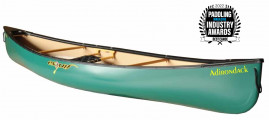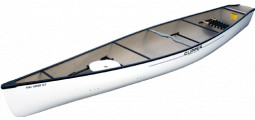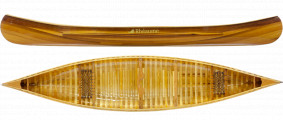Many of the best canoeing adventures begin with the lure of wild fish, a hard-to-reach lake, and the challenge of how to get there. Where I live near Lake Superior, a good fishing canoe is the only backcountry tool capable of handling the demands of finding secret, far-flung lakes that may not have seen an angler for years. The freedom to roam is integral to the design.
A good fishing canoe can not only deliver you to backcountry honey holes, but can also be just the right craft for hauling in fish when you get there. So here are the most important factors that go into finding the best fishing canoe for you.
Top picks: Best fishing canoes for 2025
The following fishing canoes have received the highest star ratings by reviewers in our Paddling Buyer’s Guide. See and review all fishing canoes here.
Best Fishing Canoes

Saranac 146
Shop best fishing canoes
Follow the links below to the Paddling Buyer’s Guide where you’ll find every fishing canoe available along with specs, prices, reviews and places to buy.
Shop by type
Shop by number of people
Shop by body of water
Shop by material
Shop by brand
Fishing canoe buying advice
The first and most crucial element to consider when choosing a canoe for fishing is where you plan to wet your line.
Are you a river angler targeting walleye, or will you be carrying over the portages to out-of-the-way ponds to go after lake trout? Perhaps you’re after the brook trout of Lake Superior, or you’re targeting trophy pike in roadside backwater bays. The dream is to own a one-size-fits-all canoe—light enough to easily portage yet tough enough to withstand the bump of rocks while you’re fighting a lunker.
Many anglers would also like a canoe that’s easily maneuverable for a solo angler yet also tracks efficiently out to the fishing grounds with the family aboard.
While there are many versatile fishing canoes, no one canoe is perfect for all purposes. Performance in one area often means compromise in another.
Almost any recreational canoe can be a serviceable fishing craft. However, the category of sporting canoes is designed specifically for hunters and anglers. These canoes tend to be shorter and wider to create a stable platform. More stability allows you to handle the disturbance caused by reeling and landing fish. You can even stand to cast and increase visibility.
Lakewater anglers tripping for a week in the backcountry may prefer a touring canoe—often with a longer waterline and deeper sides, which means more speed and greater carrying capacity on long-distance travels. And any angler who is regularly portaging from lake to lake will be pleased to have a lightweight canoe.
For anglers fishing narrow creeks and lazy rivers, a canoe with more rocker—keel-line curvature at the bow and stern of the canoe—will be easier to maneuver to small pools amid currents. One thing to consider when fishing on moving water is the toughness of the hull material. Wrestling a monster is a sure way to steal your attention from unforeseen rocks.
And though canoes can be paddled on the ocean in calm conditions, most anglers choose sit-on-top kayaks to fish the deep blue.
What’s the best type of fishing canoe?
Where you do most of your paddling will dictate the hull material that will perform the best for your fishing adventures. Material choice will determine the weight, durability and longevity of a fishing canoe.
Composite canoes
Composites refer to a range of woven fabric materials that are impregnated with resins. The most commonly used composite materials are fiberglass, aramid and carbon, with fiberglass being the most common, heaviest and least expensive of the three. Aramid (Kevlar and Twaron) and carbon blends tend to have the best strength-to-weight ratios but expect to pay more for them.
Composite canoes are stiffer than plastic, making for a faster and more responsive craft, but it means they’re ill-suited to getting knocked around on rocks, since they break before they bend (though, increasingly, some specialized composites are being made for river environments). As long as they’re not treated recklessly, expect composite canoes to last a lifetime.
Plastic polyethylene canoes
Plastic polyethylene canoes can take a beating in shallow and rocky rivers. This is the same material used to make most whitewater kayaks. Though they tend to be the cheapest type of canoe at the cash register, you’ll pay on the portage trail as they often weigh the most. Plastic laminates, like T-Formex, offer durability, performance, and some weight savings, while costing a bit more.
Wooden canoes
If aesthetics are important, nothing makes for a more lovely photo than a catch laid out upon the wooden ribs of a cedar canoe. Despite their rough-and-tumble voyageur history, nowadays, wooden canoes are showpieces and babied from rack to lake and back again.
They require maintenance to last a lifetime and are as heavy as many plastic canoes, but damn, they look and perform beautifully.
Inflatable and folding canoes
Inflatable and folding canoes are an evolving category. These canoes and kayaks offer the portability and storability needed for urban living and public transit. They’re popular at some remote fly-in fish camps for the same reasons.
They are made from a variety of materials, including vinyl and plastics, and performance can vary widely depending on the technology used. Good ones are tough enough to withstand punctures from rocks and hooks.
Is a fishing canoe stable?
Whether you fish solo or with the kids and family hound hanging over the gunwales, stability is perhaps the most critical feature for fishing canoeists. How “tippy” a canoe does or doesn’t feel is a combination of the environmental conditions, a paddler’s experience and the canoe’s design. A canoe’s stability is determined by its width and cross-sectional shape. A wider canoe is more stable, while narrow canoes are generally faster and more efficient in the water.
Flat-bottomed canoes are a favorite among sporting canoeists. Flat-bottomed hulls offer the widest platform on the water, so they feel more stable than other hull shapes in calm conditions. For sheltered water, a flat-bottom canoe is a great option. However, this shape sacrifices speed and rough water performance.
Anglers regularly fishing on large lakes or moving water may want to consider a more versatile shallow-arch or shallow-V hull, which may feel less stable initially, but will more comfortably roll with waves.
How to choose the perfect size of fishing canoe
Opt for a canoe that matches the type of fishing you often do, rather than the fishing you dream of doing. For example, if you regularly steal away for solo dawn patrol, choose a smaller canoe you can easily paddle alone. Don’t get stuck trying to solo an unwieldy 18-footer more suited to multi-week tandem fishing trips in the Boundary Waters.
A little pack boat may be ideal for dedicated solo anglers who paddle mostly protected waters. These lithe canoe-kayak hybrids were popular for pond hopping in the Adirondacks at the turn of the 20th century and they’ve made a comeback. They’re often built with featherweight composites—it’s not uncommon for a 12.5-foot design to weigh just 24 pounds and measure 27 inches wide—although other compositions are increasingly common.
Pack boats have a shallow depth and are designed to be paddled by a single canoeist sitting on the hull using a double blade, like in a kayak. They’re efficient for their length but not ideal for rough water or standing in.
A mid-size symmetrical canoe is a versatile option for anglers who fish solo sometimes and want to fish with a friend at other times. A 15-foot model can weigh anywhere from 25 pounds to more than 50 pounds, depending on hull material. It’s a size that can easily handle everything from solo wilderness tripping to day touring with a second angler aboard.
A symmetrical canoe—where the bow and stern have the same shape—allows a solo paddler the option to flip the canoe around and paddle solo from the bow seat, where they will be closer to the center of the canoe.
Of course, there’s no shortage of tandem canoe options for anglers who want to fish with friends. The significant considerations are length, gear load and location of your trip. Tandem canoes typically range from 15 to 18 feet but are available in shorter and longer designs. If bringing a third angler along, look at models 18 feet and longer with a third seat, and beware of the manufacturer’s maximum capacity.
No matter what size you settle on, don’t forget to factor in all your gear. Don’t just look at a manufacturer’s capacity limit; instead, imagine how all your equipment will fit and where.
Putting a motor on your fishing canoe
Adding a motor to your canoe opens up a world of access opportunities by changing how much gear you can take and how fast and far you go. Square-stern canoes, often referred to as freighters or sometimes square-back canoes, come with a flat surface for easy installation of an outboard engine. Since the square-stern design will moderately affect a canoe’s speed and tracking, this design is best suited for anglers who will use a motor most of the time.
Don’t have a square-stern? Another option is to use a motor mounted on a cross-hull mount. A cross-hull mount is a bracket that runs horizontally across the canoe’s stern and allows a small motor to be mounted to its left or right.
Before buying a motor and square stern canoe, check the regulations of your favorite fishing holes. Motors are prohibited or regulated in many environmentally protected areas, like national parks and conservation areas, even on canoes.
Canoe vs kayak for fishing
Over the last decade, kayak fishing has become one of North America’s fastest-growing outdoor activities. Its meteoric rise has overshadowed the age-old tradition of fishing from a canoe. So, it’s no surprise many paddlers wonder whether to purchase a canoe or kayak for fishing.
Both have their benefits, and the best choice ultimately depends on the type of fishing you like to do most often. Recognizing there are exceptions, here are some general guidelines:
Canoe pros
- Easily portaged
- Spacious, high capacity
- Versatile
Canoe cons
- Learning curve for solo paddle strokes
- Less stability, potentially
- More exposure to wind
Sit-on-top pros
- Lower center of gravity, more stable
- Options for ocean fishing
- Pedal options
- Can’t take the family
Sit-on-top cons
- Difficult to portage
- Some models need a trailer to transport
- Can’t take the family
The biggest mistake when buying a fishing canoe
The biggest mistake you can make is buying a canoe that isn’t stable enough to enjoy yourself. If you purchase a canoe you don’t enjoy being in or feel scared to paddle, then you won’t be out enjoying your floating piece of bliss very often.
Try before you buy. Demo the model in question at your local paddle shop. Stability is tough to explain accurately on land because one person’s perception may differ from someone else’s. Get on the water and do it with all your gear. Spend enough time to get comfortable.
Try casting. Bring your daughter, buddy or dog…whomever you’ll be fishing with. You’ll quickly find out what’s comfortable for you when you’re fishing.

Fishing canoe reviews
There’s no better way to choose a fishing canoe than kicking the tires and taking a test drive. Our testing includes miles of paddling and hours of fishing in a variety of conditions and locations. This allows us to evaluate how the boat handles and how it performs for the intended angler and conditions.
If you can’t get to the paddleshop or a demo day, take a test drive with our review of the best canoes for fishing.
- New Nova Craft Canoe Prospector 14 Walk-Through (Video)
- Canoe Review: Old Town Saranac 146
- Inflatable Kayak Review: Sevylor Colorado
- Solo Canoe Review: Old Town Discovery 119
- All-Around Recreational Canoe Review: Pelican 15.5
- Boat Review: Nova Craft Bob Special
- Review: Mad River Canoe Explorer 16
- Boat Review: Nova Craft Fox 14 Solo Canoe
- Canoe Review: Old Town Penobscot 164
- Boat Review: Sea Eagle Travel Canoe 16














